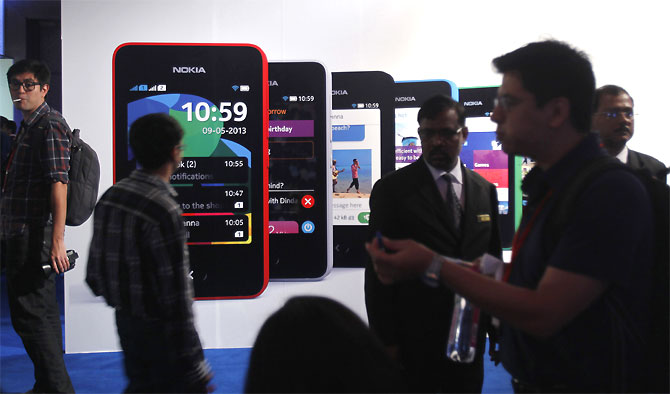 | « Back to article | Print this article |
India's big mobile broadband revolution
By 2020, mobile internet subscribers will grow four times to reach 620 million and smartphone penetration to reach 45 per cent up from current number of just around 10 per cent.
Mobile telephony is the bedrock of any economy.
Over the last decade, mobile telephony has seen exponential growth driven by access, affordability and inherent need for people to communicate.
The numbers tell the story. At the end of 2013, the country had 785 million mobile subscriptions and this number is expected to grow to 1.14 billion by 2020.
This growth is also seeing consumers adopting data as an intrinsic part of their communication need.
Yes, we have entered the data age, which will allow us to access any service anytime, anywhere.
Please click NEXT to read more…
India's big mobile broadband revolution
More and more people today are using digital services like social media, gaming, banking, ticketing, shopping to name a few.
All these diverse user needs put unique demands on networks both in terms of speed and quality of service which shapes the consumer from the networks.
We are on the cusp of a massive data revolution. Today, we have reached 160 million mobile internet subscribers consuming approx 250 MB of data.
A third of the traffic on mobile broadband networks is driven by social media, web browsing and chat.
Please click NEXT to read more...
India's big mobile broadband revolution
Video traffic is also on the rise. The manner in which data is consumed will require networks to provide ubiquitous coverage and capacity.
Today only one-third of mobile consumers are able to access internet over a mobile broadband network every time they attempt.
Mobile broadband consumers value superior network performance and rate network reliability, coverage and speed as the top three parameters for a good mobile broadband experience.
This presents a huge opportunity to the operators and they need to focus on getting the consumer experience right to be able to maximise it.
Please click NEXT to read more...
India's big mobile broadband revolution
By 2020, we estimate mobile internet subscribers to grow four times to reach 620 million and smartphone penetration to reach 45 per cent up from current number of just around 10 per cent.
To deliver a great smartphone experience three things need to be addressed - the device experience, the network experience and the app experience.
The first is being addressed effectively by handset OEMs with devices becoming faster, more capable and powerful with every passing day.
The other two are inter-related and need to be understood better. Building more and more mobile broadband network capacity and coverage ubiquity is a given.
Please click NEXT to read more...
India's big mobile broadband revolution
Ubiquity for consumers today might just mean access to a service like YouTube, but tomorrow it is likely to evolve to a great streaming experience even when they are in a remote location.
In our view, a great smartphone experience is the one when a subscriber gets over 1 megabit per second, 90 per cent of the times.
It is important to understand app consumption habits for better experience. For example, if social media today is about sharing images and text; tomorrow it will be all about sharing HD video real time.
Not all apps are born equal and it is equally important to remember no matter which app it is, it will constantly require more and more from the network.
Please click NEXT to read more...
India's big mobile broadband revolution
The advantage of an app-coverage focus is that this approach enables the integration of coverage, capacity and quality into a holistic view of network performance, allowing the operator to deliver apps that meet user expectations.
A better understanding of the consumer's app usage pattern also creates opportunities for operators to monetise services better. If a consumer is a heavy music user but not interested in video, he/she would prefer an offering tailored to that need.
To sum up, the mobile broadband revolution creating new opportunities for operators and at the same time making new demands on them to keep pace with the changing needs of consumers.
Ajay Gupta, head of strategy & marketing, Ericsson India.






